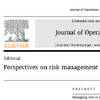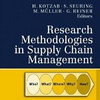 I found a very interesting article by Frank Teuteberg in Strategies and Tactics in Supply Chain Event Management
I found a very interesting article by Frank Teuteberg in Strategies and Tactics in Supply Chain Event Management. The article, Supply Chain Risk Management: A Neural Network Approach is interesting to supply chain risk researchers, because it offers a well-written and well-founded and well-illustrated chapter on the theoretical background of supply chain risk management, including a disruption classification and assessment.
Supply chain disruption
Supply chain event management (abbreviated as SCEM) is a consideration of all possible occurring events and factors that can cause a disruption in a supply chain. With SCEM possible scenarios can be created and solutions can be planned. SCEM takes on a more neutral approach to all events, not just focusing on the negative events, as supply chain risk management is likely to imply.
Reference
Teuteberg, F. (2008) Supply Chain Risk Management: A Neural Network Approach. In: Strategies and Tactics in Supply Chain Event Management. Eds. Ijoui R. et al., Springer Verlag, pp. 99-118
Author link
- linkedin.com: Frank Teuteberg












